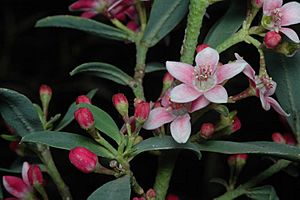Long-leaf wax-flower facts for kids
Quick facts for kids Long-leaf wax-flower |
|
|---|---|
 |
|
| In the Australian National Botanic Gardens | |
| Scientific classification |
|
| Kingdom: | Plantae |
| Clade: | Tracheophytes |
| Clade: | Angiosperms |
| Clade: | Eudicots |
| Clade: | Rosids |
| Order: | Sapindales |
| Family: | Rutaceae |
| Genus: | Philotheca |
| Species: | |
| Subspecies: |
P. m. subsp. myoporoides
|
| Trinomial name | |
| Philotheca myoporoides subsp. myoporoides (DC.) Bayly
|
|
| Synonyms | |
|
List
|
|
The long-leaf wax flower (Philotheca myoporoides subsp. myoporoides) is a beautiful flowering plant. It belongs to the Rutaceae family, which also includes citrus fruits. This plant is special because it only grows in south-eastern Australia. It's a type of shrub that can sometimes even grow into a small tree. It has leaves that are shaped like long ovals or eggs. Its flowers are usually white or pink and grow in small groups where the leaves meet the stem.
Contents
What Does the Long-Leaf Wax Flower Look Like?
The long-leaf wax flower is a shrub that can grow up to 2.5 meters (about 8 feet) tall. Its stems are smooth and have small, bumpy glands.
Leaves
The leaves of this plant can look different from one plant to another. They are usually shaped like long ovals or eggs. They can be from 20 to 110 millimeters (about 0.8 to 4.3 inches) long. They are also 6 to 22 millimeters (about 0.2 to 0.9 inches) wide. The leaves have bumpy glands and a clear line down the middle.
Flowers
The flowers grow in groups of three to eight. These groups appear where the leaves join the stem. Each group of flowers grows on a small stalk called a peduncle, which is 0.5 to 20 millimeters long. Each individual flower sits on an even smaller stalk called a pedicel, which is 4 to 10 millimeters long.
The petals of the flowers are wide and oval-shaped. They can be white or pink and are about 8 millimeters (0.3 inches) long. Inside the flower, the stamens (the parts that make pollen) are separate from each other and have tiny hairs.
Flowering Time and Fruit
You can see the long-leaf wax flower blooming from July to January. After the flowers, the plant produces a fruit. This fruit is about 7 millimeters (0.3 inches) long and has a small beak-like tip about 3 millimeters (0.1 inches) long.
How Did It Get Its Name?
Plants often get their scientific names changed over time as scientists learn more.
Original Naming
In 1824, a scientist named de Candolle first described this plant. He gave it the name Eriostemon myoporoides in his book Prodromus Systematis Naturalis Regni Vegetabilis.
Name Change
Later, in 1988, another scientist named Michael Bayly studied the plant again. He decided to change its name to Philotheca myoporoides. He published this new name in a science journal called Muelleria. In the same paper, Bayly also described nine different types (subspecies) of this plant, including the one we are talking about, subspecies myoporoides.
Where Does It Grow?
The myoporoides subspecies is the most common and widespread type of long-leaf wax flower. It grows mainly along the Great Dividing Range in Australia.
Location
You can find it from a town called Denman in New South Wales all the way down to near Healesville in Victoria.
Habitat
This plant likes to grow in forests and heathlands. It often grows near water sources like streams or on rocky hillsides.


